Grow Nutrient-Rich Microgreen Seeds at Home
The Dietary Guidelines for Americans suggest eating 2½ cup-equivalents of vegetables daily for a 2,000-calorie diet. These veggies are full of nutrients like fiber, vitamins, and minerals. They’re essential for our health. Gardening tools, garden tools, gardening equipment, garden supplies, lawn tools, landscaping tools, horticultural tools, yard tools, gardening accessories, and garden maintenance tools can help you grow these greens at home.
Key Takeaways
- Microgreens are packed with vitamins, minerals, and antioxidants, making them a highly nutritious addition to your diet.
- Growing microgreens at home is an easy and rewarding experience that can provide you with fresh, nutrient-rich greens.
- Microgreens require minimal space and can be grown indoors, even in low-light conditions near a window.
- Microgreens can be harvested quickly, typically within 7-14 days after sowing the seeds.
- Various seed varieties, including broccoli, kale, and radish, can be grown as microgreens, each offering unique flavors and nutritional profiles.
What are Microgreens?
Microgreens are tiny, nutrient-packed greens that you can grow at home. They can thrive on a windowsill or in your kitchen. These small versions of vegetables and herbs are full of vitamins, minerals, and antioxidants. They make a great addition to your meals and are easy to grow.
They are harvested in just 7 to 21 days after germination. This makes them a quick way to get fresh, tasty greens. Plus, they offer a calming gardening experience.
There are over 40 types of microgreens you can grow, like broccoli, radish, and kale. Each type has its own flavor and nutrients. This lets you try out new recipes and flavors.
But, some microgreens like tomato and pepper are not safe to eat at this stage. They have toxic compounds that can harm you.
You can find microgreen seeds online or at local stores. They come with instructions on how to grow them. It’s important to know how many seeds to use in your space to grow them well.
“Microgreens are an exciting new food source for the 21st century, with the potential to address malnutrition and provide essential nutrients.”
Microgreens are being studied for their health benefits. They are full of nutrients and antioxidants. Growing them at home is a fun and healthy way to eat.
Benefits of Growing Microgreens at Home
Growing microgreens at home is more than just getting fresh greens. It’s a way to enjoy gardening and reduce stress. Even with little space, you can grow these easy-to-maintain greens and enjoy their quick harvests.
Nutrient-Dense Superfoods
Microgreens are full of vitamins, minerals, and antioxidants. They have more nutrients than regular greens. This makes them a superfood that’s good for you.
Convenient and Space-Saving
Microgreens need little space to grow. You can use small containers or a sunny windowsill. They’re perfect for those with limited garden space. You get to enjoy fresh greens without a big garden.
Stress-Relieving Gardening
Looking after your microgreen garden is calming. Watching the seeds grow into healthy greens is fulfilling. It’s a way to relax and improve your well-being.
Quick Harvests
Microgreens grow fast, ready to eat in 7 to 14 days. This means you can have fresh greens often. You don’t have to wait long like with regular vegetables.
Adding microgreens to your meals is great for your health and your garden. Whether you have a big garden or just a windowsill, growing microgreens is easy and rewarding. It’s a step towards a healthier, greener life.
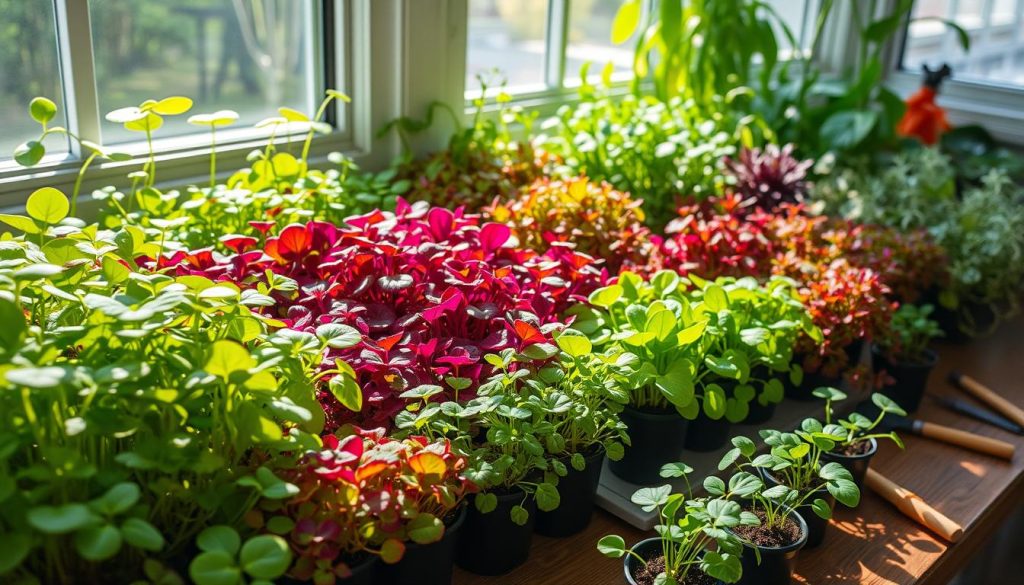
Tools and Materials Needed
To grow microgreens at home, you’ll need some key gardening tools and supplies. You’ll need seeds, growing containers, a good growing medium, water, and tools like scissors or a sharp knife.
Here are the main gardening equipment and materials you’ll need:
- Microgreen Seeds: Pick from tasty and healthy options like arugula, sunflower, kale, or radish seeds.
- Growing Containers: Use 1020 trays with or without drainage holes, or 8oz deli containers with lids for a smaller setup.
- Growing Medium: Coco coir blocks, coco coir bricks, or hydroponic nutrient solutions are good for microgreens.
- Watering Tools: A pump mister or spray bottle is great for watering your microgreens.
- Harvesting Tools: A sharp folding knife or scissors makes cutting your microgreens easy.
- Specialty Accessories: Think about a seed starting mat and humidity dome for the best growing conditions.
With the right gardening tools and supplies, you can grow a great microgreen garden at home or in your kitchen. Choose quality, sustainable options to help your microgreens grow well.
| Item | Recommendation |
|---|---|
| Growing Trays | 50% 1020 trays with holes, 50% 1020 trays without holes |
| Containers | 50% 8oz deli containers with lids |
| Growing Medium | 33.3% Coco Coir Blocks, 33.3% Coco Coir Bricks, 33.3% Hydroponic Nutrient |
| Essential Tools | 40% for growth (Seed Starting Mat, Pump Mister), 20% for harvesting (Sharp Folding Knife) |
| Microgreen Seeds | 50% Arugula Seeds, 50% Black Oil Sunflower Seeds |
Having the right gardening tools and materials is key to growing microgreens. With some prep and the right garden supplies, you can grow your own microgreens at home.
Selecting the Right Seeds
Choosing the right seeds is key when growing microgreens at home. There are many types of microgreen seeds, each with its own taste, texture, and nutrients. It’s important to pick seeds that fit your taste and growing conditions for a good harvest.
Burpee Wild Arugula Selvatica seeds are great for beginners because they grow easily and quickly. Mountain Valley Seed Company Store Ruby Queen Beet seeds are loved for their tasty beet microgreens. Mountain Valley Seed Company Store Waltham 29 Broccoli seeds are versatile and easy to grow.
Burpee Sweet Success Slicing Cucumber seeds are sweet and delicious. Mountain Valley Seed Company Store Red Acre Cabbage seeds add an earthy and peppery flavor. Little Hogweed Seeds Organic Purslane seeds offer a unique tartness, popular in Europe.
The The Mix!!! 2000+ Seeds Microgreens Mix 40 Varieties offers a wide variety of microgreen seeds. The The Superfood Microgreen Seeds Mix has a blend of Purple Kohlrabi, Collard, Radish, Turnip & Broccoli Sprouts Seeds. The 12 Variety Pack Microgreens Seeds Kit and the 10 Variety Pack Microgreens Seeds package give you many options.
When picking microgreen seeds, think about the plant family. This can tell you about the taste, growing needs, and health benefits of the microgreens. For example, arugula microgreens are peppery and can handle heat. Beet microgreens are known for their color, mild taste, and health perks like lowering blood pressure and fighting inflammation.
Burpee, with 125 years of farming and seed making, is a trusted name for microgreens. They offer organic, non-GMO seeds made just for microgreens. These seeds ensure good germination and growth.
When buying microgreen seeds, look at seed quantity per tray, germination speed, germination rate, and days to maturity. Choosing the right seeds is crucial for a successful microgreen growing experience. It ensures a rich and tasty harvest.

Preparing the Growing Medium and Containers
When growing microgreens at home, the right growing medium and containers are key. Popular choices include peat-based mixes, coconut coir, and mats from natural or synthetic fibers. The medium you pick affects how well it holds moisture and how often you need to water.
For successful microgreens, use clean containers with drainage holes. Fill them with a good growing medium. The Home Microgreens Potting Mix is a top choice, leading in growth and speed. Coconut coir mats are thick and keep water well, often needing soaking first. TerraFibre Hemp Matting and Bamboo Grow Mats are also great, with their thick, easy-to-penetrate textures.
After filling containers, water from the bottom to spread moisture evenly. This method stops uneven drying and helps microgreen seeds grow well.
| Growing Medium | Key Attributes | Performance Ranking |
|---|---|---|
| Home Microgreens Potting Mix | Outperforms other mediums, better growth results, quicker growth rates | 1 |
| Coconut Coir Grow Mat | Thick, high water retention, may require soaking before use | 2 |
| TerraFibre Hemp Matting | Thicker, more penetrable texture, easily accessible | 3 |
| Bamboo Grow Mat | Renewable, clean when cut, good water retention | 4 |
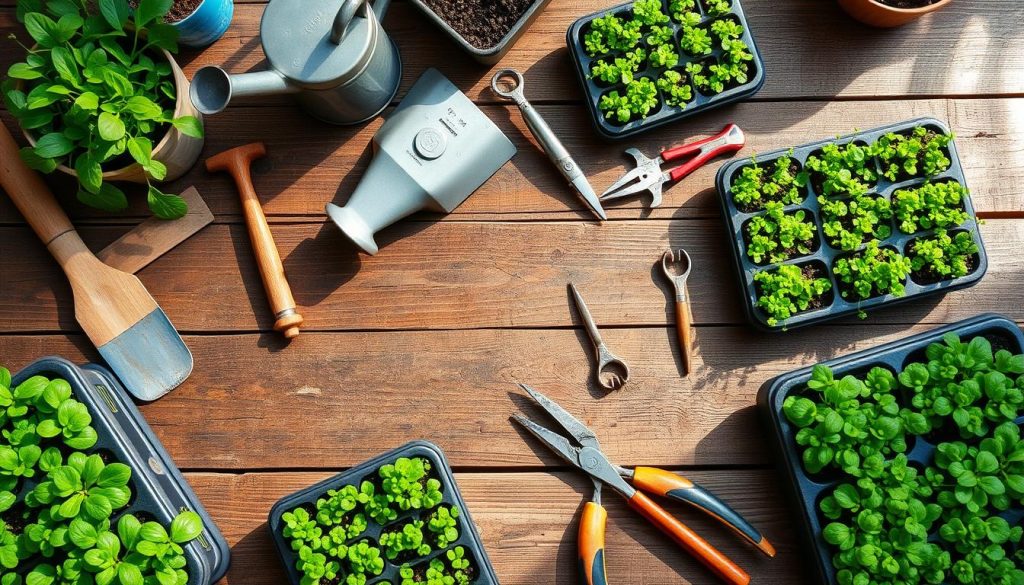
“Microgreens contain 4 to 10 times more nutrients than fully mature vegetables or herbs.”
Sowing microgreen seeds
Growing nutrient-rich microgreens at home starts with sowing the seeds right. First, fill your containers or trays with a good growing medium like coconut coir or peat moss. Then, wet the medium from the bottom, letting any extra water drain off. This keeps the surface moist but not too wet.
Next, spread the microgreen seeds evenly over the medium. The amount you need varies by seed type. For example, you might use 15 grams (0.5 oz) per 1020 tray for small seeds like amaranth, or 100 grams (3.5 oz) for bigger seeds like buckwheat. Some seeds do well with a pre-soak to help them germinate faster.
- Evenly distribute microgreen seeds over the growing medium
- Follow the recommended seeding rate for the specific variety
- Consider pre-soaking some seeds to speed up germination
Getting the seeds spread out evenly is important for even growth and a good harvest. With practice, you’ll soon have a lush, nutrient-packed bed of microgreens. Remember, the key to great microgreens is sowing the seeds correctly.
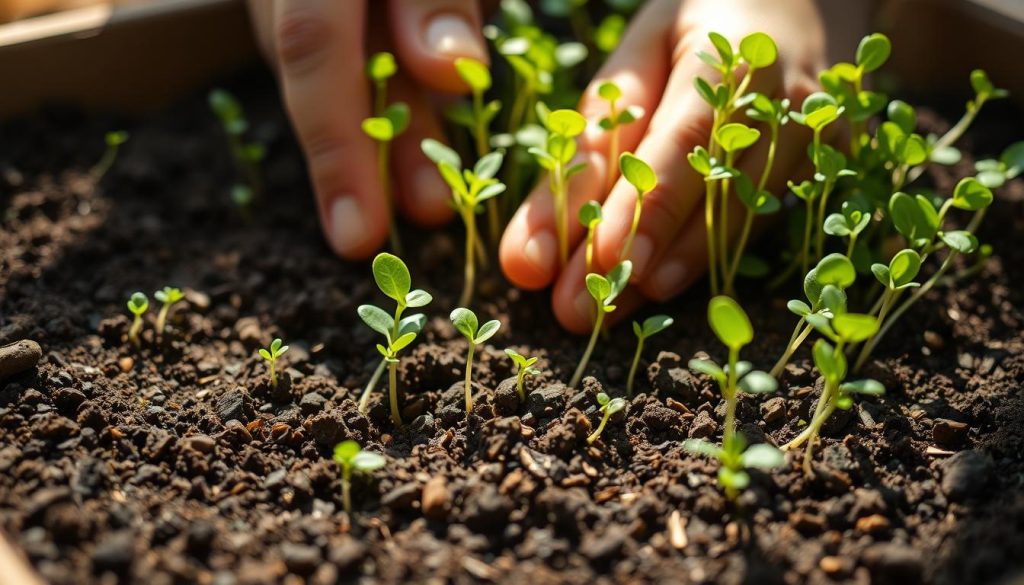
“Microgreens are a powerhouse of nutrients, and growing them at home is a rewarding experience. Sowing the seeds correctly is the first step to a bountiful harvest.”
Germination and Growth
Getting your gardening tools, garden tools, and gardening equipment to grow well is key. After you plant the garden supplies, make sure they have the best chance to grow. This means giving them the right conditions to start and keep growing.
To help seeds germinate, keep the trays covered and dark at first. This dark period helps the seeds sprout by mimicking nature. The time in the dark can be 4 to 6 days, depending on the lawn tools, landscaping tools, and horticultural tools you’re growing.
When the yard tools and gardening accessories start to grow, move them to sunlight or grow lights. This change tells the plants to start making their own food through photosynthesis. Good lighting is key for growing strong, healthy garden maintenance tools.
“The key to successful microgreen cultivation is providing the right conditions for germination and early growth.” – Expert Horticulturist
By managing the germination stage well and moving the microgreens to bright light, you can get a lot of nutrient-rich gardening tools and garden tools. Keeping the right amount of moisture and temperature is also vital for their growth and health.
| Microgreen Variety | Blackout Period | Germination Time | Harvest Time |
|---|---|---|---|
| Amaranth | 5-6 days | 2-3 days | 10-12 days |
| Arugula | 4-6 days | 2-3 days | 8-10 days |
| Basil | 3-4 days | 3-4 days | 20-25 days |
| Broccoli | 4-6 days | 3-4 days | 10 days |
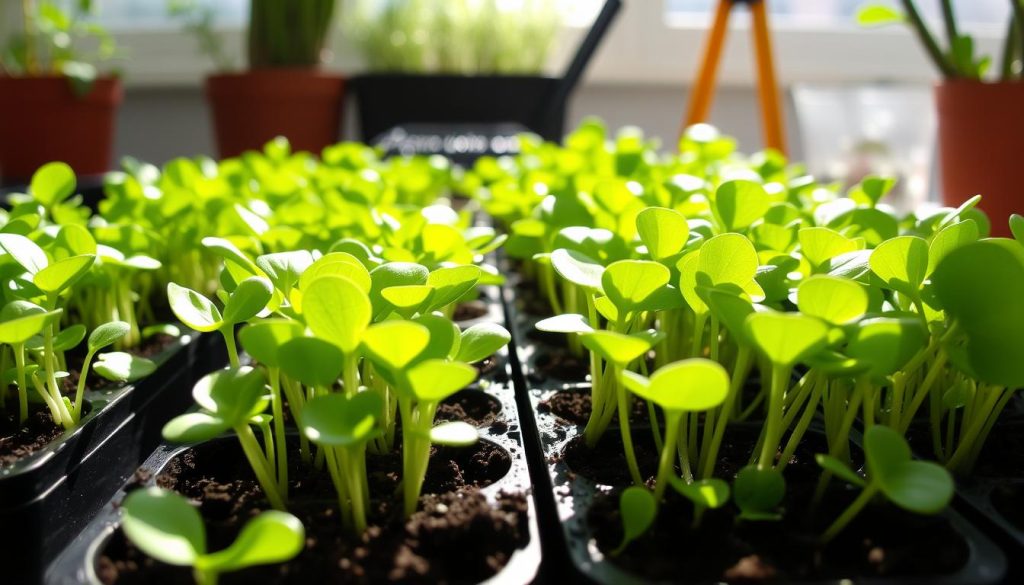
Watering and Care
Proper watering and care are key for growing healthy microgreens at home. The right amount of moisture is crucial. Too much water can cause mold, while too little can slow down the plants.
To keep your microgreens in top shape, water from the bottom. This stops the leaves from getting too wet and lowers mold risk. Tools like pump sprayers or atomizers are great for watering without harming the tiny plants.
- Water the trays when the soil feels dry, usually once or twice a day as the plants grow.
- Change how often you water based on the microgreen type and its stage of growth, as some need more or less water.
- Make sure to remove any extra water from the bottom tray to let the roots breathe.
- Keep an eye on the humidity and open a window now and then to let air in and stop mold.
Keeping your gardening area clean is also vital. Clean your trays and tools often to avoid pests and diseases. Also, check your water quality and adjust the pH if needed for the best microgreen growth.
“Consistent, gentle watering and maintaining a clean, well-ventilated grow space are the keys to successful microgreen cultivation at home.”
By sticking to these gardening tips, you can make sure your microgreens do well. This will give you a lot of fresh, healthy greens for your meals.
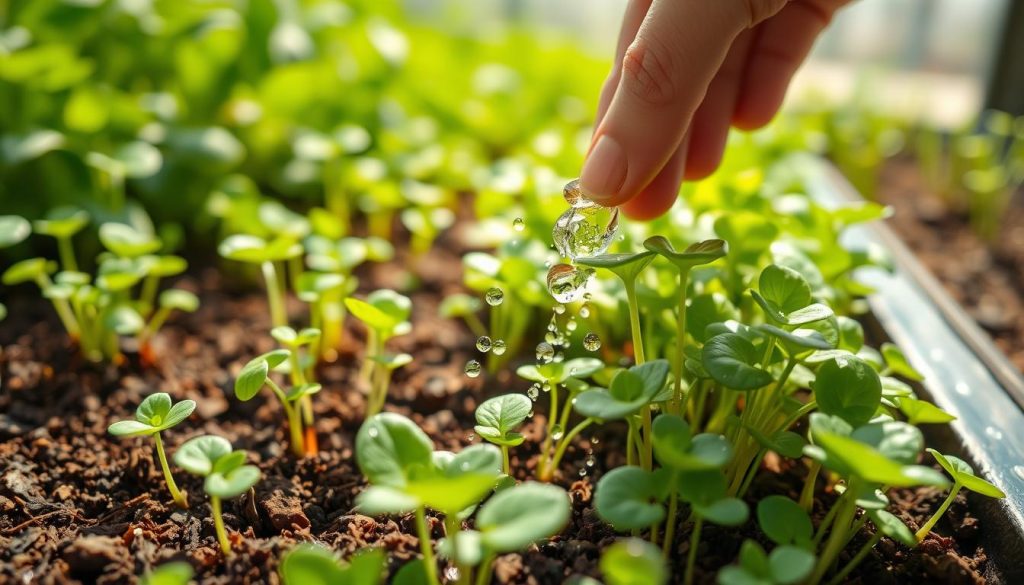
Harvesting Your Microgreens
Growing your own gardening tools, garden tools, gardening equipment, and garden supplies ends with harvesting your tasty microgreens. They are ready in 7-14 days after sowing the lawn tools, landscaping tools, horticultural tools, and yard tools. To harvest, cut the greens just above the soil line with a clean pair of gardening accessories or a sharp garden maintenance tools.
The best time to pick your microgreens varies by type. Some, like the Minowase Daikon Radish, are ready in 10-15 days. Others might take up to 30 days. Watch for the right color, size, and look to pick at peak freshness and nutrition.
“Microgreens don’t require fertilization throughout their growth cycle, as they are harvested at a very young age.”
Harvesting right is key. Use clean, sharp scissors or a knife to avoid harming the greens. After picking, rinse the microgreens in cold water to clean off dirt. Then, dry them with a clean paper towel. Keep them in the fridge, where they’ll stay fresh for a week.
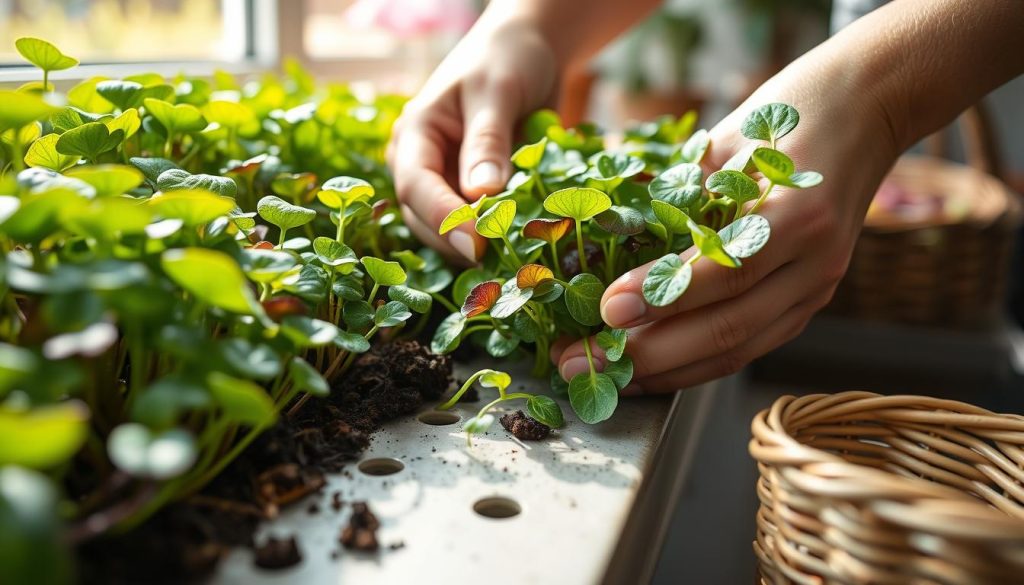
By following these easy steps, you can enjoy the nutritional benefits of your gardening tools, garden tools, gardening equipment, and garden supplies. Happy harvesting!
Popular Microgreen Varieties
When growing gardening tools and garden tools for microgreens at home, you have many tasty options. Broccoli, radish, kale, mustard greens, and sunflower greens are favorites. Each type brings unique flavors and lots of nutrients.
Broccoli Microgreens
Broccoli sprouts are a top choice for gardening equipment and garden supplies. They’re packed with sulforaphane, a strong antioxidant. This makes them a great pick for health lovers.
Radish Microgreens
Radish microgreens grow fast, taking just 1-2 days to sprout and 5-10 days to harvest. These lawn tools and landscaping tools add a spicy kick to any dish.
Kale Microgreens
Kale microgreens are full of vitamins, minerals, and antioxidants. They add a slightly bitter taste to meals. These horticultural tools and yard tools are perfect for health enthusiasts.
Mustard Microgreens
Mustard microgreens bring a spicy flavor, from mild to strong. They take 3-4 days to sprout and 6-10 days to be ready. These gardening accessories and garden maintenance tools are a hit with food lovers.
Sunflower Microgreens
Sunflower microgreens are both pretty and nutritious. They’re full of vitamins, minerals, and antioxidants. These gardening tools and garden tools microgreens are ready in 10-14 days.
Whether you like mild, spicy, or herb-like tastes, there are many gardening equipment and garden supplies microgreens to try. They’re perfect for adding to your homegrown microgreen collection.
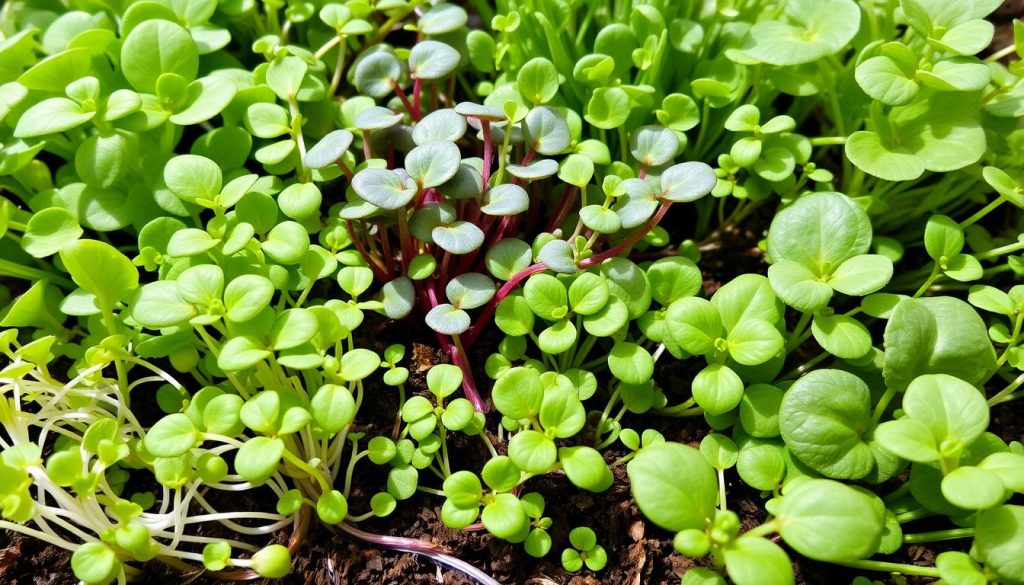
Incorporating Microgreens into Your Diet
Microgreens are more than just a garnish. They can be a tasty and nutritious addition to many dishes. You can use them to top soups, salads, wraps, and even smoothies. They make your meals more exciting and healthy.
Microgreens like broccoli, radish, and kale are full of vitamins, minerals, and antioxidants. They are a nutritional powerhouse. In fact, they can have up to 40 times more nutrients than regular greens. Broccoli microgreens are especially good for iron, potassium, and zinc.
To add microgreens to your meals, try these ideas:
- Sprinkle microgreens on soups, stews, and chilis for flavor and nutrition.
- Add microgreens to salads, grain bowls, and wraps for a crunchy topping.
- Blend microgreens into smoothies and juices for antioxidants and vitamins.
- Use microgreens as a garnish for sandwiches, tacos, and burritos for looks and taste.
- Mix microgreens with pasta dishes, pizza, or omelets for better flavor.
Microgreens are versatile and packed with nutrients. They can be a great addition to any meal. Try different types and find new ways to use them for a tasty and healthy diet.
| Microgreen Variety | Flavor Profile | Best Uses |
|---|---|---|
| Broccoli Microgreens | Mild, sweet, earthy | Salads, sandwiches, soups, smoothies |
| Radish Microgreens | Peppery, slightly spicy | Tacos, wraps, garnishes, salads |
| Kale Microgreens | Slightly bitter, earthy | Salads, pasta dishes, stir-fries |
| Sunflower Microgreens | Nutty, sweet | Snacks, smoothies, salads |
“Microgreens are a powerful way to boost the nutritional value of your meals. Their concentrated nutrient profile makes them a must-have for any health-conscious home cook.”
Troubleshooting Common Issues
Growing your own microgreens at home can be rewarding but comes with challenges. You might face a few common issues. Knowing these problems and fixing them quickly can help you have a successful harvest.
Mold Growth
Mold is a common issue when growing microgreens. It thrives in moist places and can spread fast. To stop mold, make sure there’s good air flow, don’t overwater, and keep your containers clean.
Pest Infestations
Pests like aphids, fungus gnats, or whiteflies can bother your microgreens. These pests can eat the greens, making them grow poorly and reducing your yield. Watch your microgreen trays closely and deal with pests fast using organic methods.
Nutrient Deficiencies
Microgreens need the right nutrients to grow well. Without them, they might look bad, grow slowly, or not germinate well. Make sure your growing medium is full of nutrients. If needed, add a little organic liquid fertilizer.
By taking care of your growing conditions and solving problems like mold, pests, and nutrient issues, you can have a great harvest of these healthy greens.
| Seed Variety | Seeds per Weight |
|---|---|
| Radish Pink Microgreen | 170 seeds in 200 gm |
| Pak Choi Microgreen | 120 seeds in 100 gm |
| Red Cabbage Microgreen | 330 seeds in 50 gms |
| Radish China Rose Microgreen | 220 seeds in 200 gm |
| Broccoli Microgreen | 300 seeds in 50 gm |
| Corn Microgreen | 160 seeds in 100 gms |
| Turnip Purple Top Microgreen | 110 seeds in 100 gms |
This table shows the different seed counts and weights for various microgreens. It’s important to pick the right seeds and amounts for a good harvest.
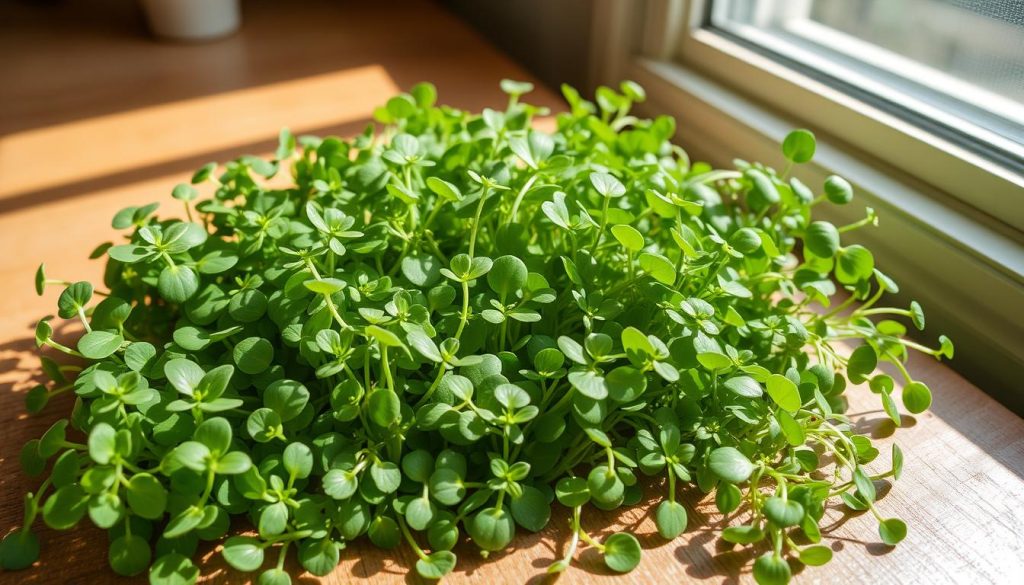
“Proper care and attention to growing conditions are key to overcoming common challenges in microgreen cultivation. With a little troubleshooting and diligence, you can ensure a thriving and bountiful harvest of these nutrient-rich greens.”
microgreen seeds Suppliers and Resources
Growing microgreens at home is a fun gardening project that can be done all year, even in small spaces. You’ll need good seeds and the right tools to start. Luckily, there are many trusted suppliers and resources to help you grow microgreens at home.
Variety of Microgreen Seeds
Online stores like Eden Brothers have over 280 microgreen seed varieties. They offer a wide range of seeds for different tastes and health needs. You can find everything from common greens like kale and broccoli to unique ones like amaranth and buckwheat.
Essential Microgreen Growing Supplies
- Seedling trays or containers with drainage holes
- Potting soil or growing medium, such as coconut coir
- Microgreen seeds of your choice
- Grow lights or a sunny windowsill (for optimal growth)
- Humidity dome or plastic wrap (to maintain moisture)
- Scissors or a sharp knife for harvesting
With these basic tools and the right seeds, you can create a successful indoor microgreen garden at home.
Convenient Microgreen Growing Kits
For an easy microgreen growing experience, many brands offer starter kits. These kits come with a self-watering tray, growing medium, and microgreen seeds. The Windowsill Self-Watering Microgreens Tray and Coir Discs are great examples of easy-to-use growing solutions.
By checking out these suppliers and resources, you can enjoy the fresh flavors and health benefits of growing microgreens at home. Your kitchen will become a lively urban garden.
Conclusion
Growing microgreens at home is rewarding and easy. It gives you a steady supply of nutrient-dense greens. By following this guide, you can grow various microgreens in your kitchen or living space. Enjoy fresh, flavorful, and nutritious greens in your meals.
It doesn’t matter if you’re new to gardening or experienced. Growing microgreens is a great way to add vitamins, minerals, and antioxidants to your diet. With the right gardening tools and garden supplies, you can make your home a microgreen oasis. This provides a steady source of nutrient-rich greens for your cooking.
The demand for microgreens is rising in both the commercial and home-gardening worlds. Exploring their versatility and health benefits is rewarding. By using microgreens, you can improve the flavor and nutrition of your meals. It’s also a fulfilling gardening activity that relaxes the mind and nourishes the body.